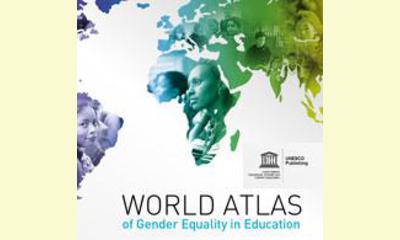|
|
Launch of World Atlas of Gender Equality in Education
an article by UNESCO
To mark International Women’s Day, UNESCO and the UNESCO Institute for Statistics have jointly released the World Atlas of Gender Equality in Education, which includes over 120 maps, charts and tables featuring a wide range of sex-disaggregated indicators.

click on photo to enlarge
The vivid presentation of information and analysis calls attention to persistent gender disparities and the need for greater focus on girls’ education as a human right.
The atlas illustrates the educational pathways of girls and boys and the changes in gender disparities over time. It hones in on the gender impact of critical factors such as national wealth, geographic location, investment in education, and fields of study.
The data show that:
* Although access to education remains a challenge in many countries, girls enrolled in primary school tend to outperform boys. Dropout rates are higher for boys than girls in 63% of countries with data.
* Countries with high proportions of girls enrolled in secondary education have more women teaching primary education than men.
* Women are the majority of tertiary students in two-thirds of countries with available data. However, men continue to dominate the highest levels of study, accounting for 56% of PhD graduates and 71% of researchers.
The atlas also provides a fresh perspective on the progress countries are making towards gender-related targets set by the international community under Education for All and the Millennium Development Goals.
The print edition of the atlas will be accompanied by an online data mapping tool that enables users to track trends over time, adapt maps and export data. This eAtlas will be regularly updated with the latest available data from the UNESCO Institute for Statistics.
Download the full report or obtain a printed copy.
Individual chapters, as follows, may also be downloaded on the UNESCO site.
Introduction
Chapter 1 - Increased Worldwide Demand for Quality Schooling
Chapter 2 - Girls' Right to Education
Chapter 3 - Enrolment and Gender Trends: Primary Education
Chapter 4 - Enrolment and Gender Trends: Secondary Education
Chapter 5 - Enrolment and Gender Trends: Tertiary Education
Chapter 6 - Trends in School Life Expectancy
Chapter 7 - Gender Trends: Adult and Youth Literacy
Chapter 8 - How Policies Affect Gender Equality in Education
Chapter 9 - Glossary and Index
French and Spanish language editions are forthcoming.
|








|
DISCUSSION
Question(s) related to this article:
Gender equality in education, Is it advancing?
* * * * *
Latest reader comment:
Re: Gender equality in education: is it advancing
Considering that the first women to somehow get into universities was in the 19th C, we are making tortoise-like progress. Although there are more women than men in most schools now they tend toward the Arts where they are scorned by men in science. That's the kind of thing that was passed around 60 - 70 years ago but it's still here today. But, there is a trend that will make a difference quite soon: the majority of regional politicians are women who are Arts grads and they are going to shift the weight of policy to domestic from global. That will mean less war, more peace, more freedom and better education for women.

|
|









